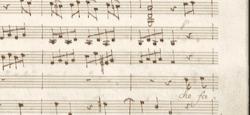(This essay also discusses the High ➏ Drop.)
Term by Robert O. Gjerdingen.
A Converging cadence, which is a type of half cadence, “is so named by virtue of the way its two outer voices move toward each other, converging on the dominant” (Gjerdingen (2007), p. 159).
The Two-Part Converging Cadence
A Converging cadence can occur in two parts, the two models of which you can see below:

The chromatically rising bass of the Converging cadence results in a certain tonal ambiguity, although ♯④ is more often ornamental than modulating.
Note that the Converging cadence bears great similarities to other schemata:
- its upper voice is identical to the upper voice of the Modulating Prinner (for more information on the Modulating Prinner see my essay Variants of the Prinner (Part 3))
- in the case of the first model, its bass is identical to the bass of the Monte (for more information on the Monte see my essay The Monte:The Basics).
The High ➏ Drop
An important ornament in the melody of a Converging cadence is what Gjerdingen calls a High ➏ Drop. Instead of setting ④ with ➋ (a vertical sixth), it is set with a high ➏ (a vertical third), interrupting the stepwise descent. As such, the snippet ➋–➊ is pushed back slightly, with both notes serving as counterpoint to ♯④. The descent from ➏ to ➋ can be in thirds or stepwise.

The Three-Part Converging Cadence
In a three-part texture, the ➌–➋–➊–➐ line is usually accompanied with a line that starts a third higher or a sixth lower and also descends stepwise. (These two lines thus move in parallel thirds or sixths and in contrary motion with the bass.)

Notice that the concluding bass progression ♯④–⑤ of a three-part Converging cadence is set as a Jommelli.
Composers also set ④, ♯④ and ⑤ with double suspensions:

Notice the diminished octave (➍ against ♯④) on beat 4 of bar 1 in both models, typical of the galant style. C.P.E. Bach was particularly fond of this variant.
Select Bibliography
Gjerdingen, Robert O. Music in the Galant Style (New York: Oxford University Press, 2007).
